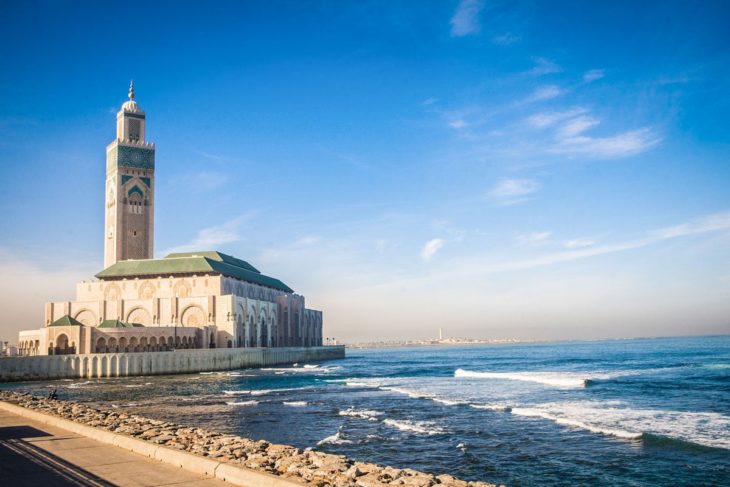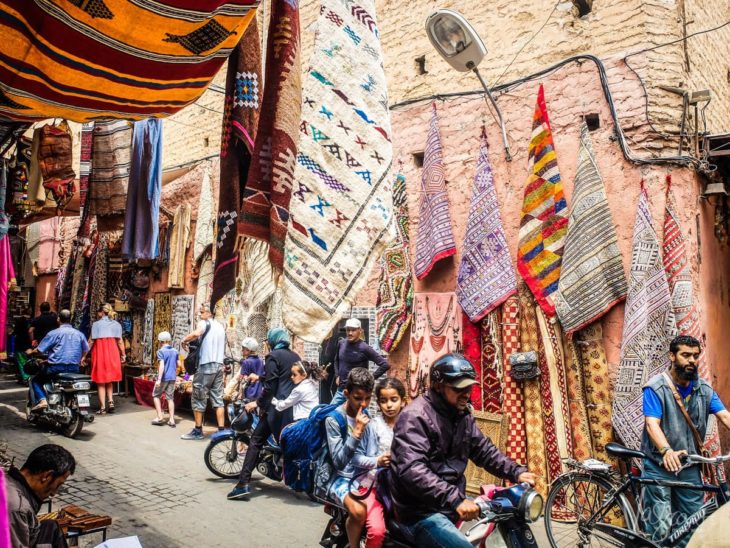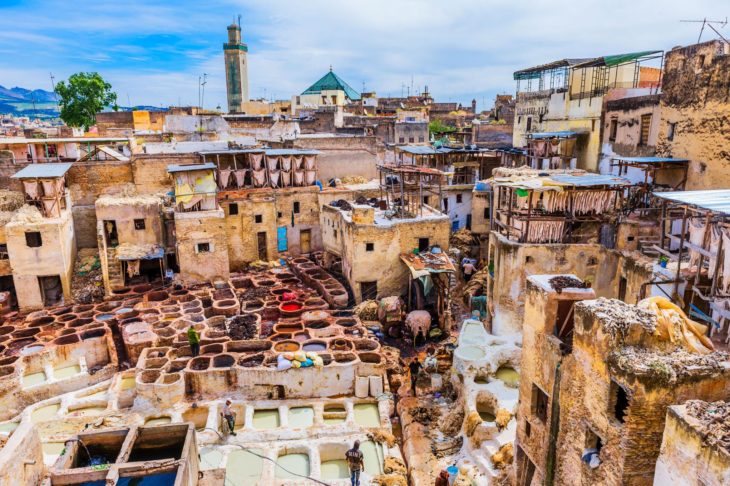There is nothing like traveling with another person to truly test a relationship. So when my boyfriend suggested that for his first real trip out of the country we head to Morocco, I said sure, this will turn out great. And actually? It kind of did.
We booked tickets for a nine-day trip to Morocco, flying into Casablanca and traveling to Fez and Marrakech, too. Casablanca is considered the most modern and least interesting of the cities, so we planned to fly in and then head out to Fez as soon as possible. Even before we got off the plane, I felt an intense sense that something made me different — because Morocco is a Muslim country, travel guides advise that you cover your knees and shoulders in public, as a sign of respect. I had done that, but just barely, and was keenly aware of the women surrounding me in cloaking hijabs and burqas, who probably felt that seeing my ankles was scandalous. I made a mental note that — despite the sweltering 90-degree weather — I needed to buy full-length leggings to wear under my skirts.
After visiting the third largest mosque in the world, the Hassan II mosque in Casablanca, we jumped on a very not air-conditioned train and headed to Fez. And that’s when the real mindfuck began. Fez is considered the cultural capital of Morocco — it’s the second-largest city in Morocco, and a very important spiritual city for Muslims (supposedly it’s called the Mecca of the West). Fez is well known for the stupid hats that Shriners wear, but also for its mesmerizing and deeply confusing medina streets (FYI, the word medina refers to a walled old city with narrow streets and no car traffic). Fez has a new city — well, comparatively new, it was built 700 years ago — but the medina is the center attraction. Walking through the winding, narrow pathways you see glimpses into the past. Donkey carts crowd the street and compete with motorbikes and bicycles and people rushing to and fro. As the day goes on, and sunrises, the streets begin to clear. Suddenly the crush of people and carts dies down, as people retire to their homes to escape the sun. We didn’t know that, of course, so on our first day, we sweat it out in strangely empty medina streets, dust and grime collecting on our faces as we plodded through the tiny pathways.

Source: vagrantsoftheworld
What might you see in the streets of the medina maze? Everything from shopkeepers hawking argan oil and spices, to cheap designer knockoffs, to old men drinking mint tea at small tables, to decapitated camel heads. (Yes, camel heads. Camel meat is eaten in Morocco.) Shops selling the same merchandise are often grouped together, created unofficial “fabric zones” or “jewelry zones” amidst the souks. Of particular interest to leather fans is the leather souq, which contains the oldest leather tannery in the world. You can see donkeys and mules carting large numbers of animal pellets into the leather souq for stripping and dying. It’s very, uh, smelly, but it’s also mesmerizing. Things continue on in the medina as they did thousands of years ago.
Our home for the first couple of days in Fez was Riad El Yacout. A riad is a Moroccan house or former palace built around a central interior courtyard. Many riads have been transformed into hotels — Riad Yacout was built in the 14th century and still contains much of the original tile and woodwork. A special fact about Riad El Yacout — U2 stayed there to record their album No Line On the Horizon, no big deal. There’s a picture of Bono by the door that I took a snap of, but sadly accidentally deleted it. The main thing about riads is that their design is meant to invoke serenity and calm in contrast to the bustling craziness of the city streets — and it’s crazy how well they actually do the job. One particularly lovely facet of El Yacout: The plunge pool which allows guests to comfortably cool off and relax. Riads also typically serve dinner and breakfast, so we often ate at the riad at night, to make our lives easier. I won’t bore you with intensive food descriptions — after all, my boyfriend and I are both vegan, so meals mostly consisted of couscous and more couscous — but I’m told Moroccan dishes with meat are pretty tasty.
After a couple of days, we moved on to another riad in a different part of town: Palais Amani is a much bigger, stunningly restored building, with a hammam and spa. What’s a hammam, you ask? It’s basically a public bath. But in Morocco, you can have a private bath service that involves a skin-brightening scrub down. I had one of those, which was fascinating — there was a litany of different treatments, including a bran scrub, a henna hair mask and a eucalyptus treatment, before a hammam attendant takes an abrasive mit and sloughs off all your dead skin. My boyfriend — who hates being touched by strangers — passed on all of that.
Special treats like hammam services seemed necessary as a way to combat the shocking heat and intense speed of things in the medina. It seems that Fassis operate at two speeds — very, very fast, and mind-numbingly slow. Most of life on the city streets moves at a whirlwind pace. Oh, and also? There were cats and kittens everywhere, just hanging out.

Source: vagrantsoftheworld
After three days in Fez, we hopped on a train to take the eight-hour journey to Marrakech. The first-class train ride cost us around $30 each — way less than you’d ever pay for an Amtrak ticket. The landscape between Fez and Marrakech was vast expanses of plains, dotted occasionally by a few small shacks. Sadly, we didn’t get a chance to go up into the mountains — the Atlas range borders Marrakech, and play a large part in defining the culture and history of the country. The mountains are the home space of the Berber peoples, who were some of the original peoples to inhabit Morrocco’s land. They speak Berber, instead of Arabic or French. For a long time, the Berbers were a marginalized population, persecuted by Arab regimes. In recent years, Morocco has increasingly embraced its Berber heritage.
Marrakech is, along with Fez, one of the major imperial cities of Morocco, and is a critical cultural and economic stronghold. Like Fez, Marrakech has a newer city section, called Gueliz, and an older medina. Marrakech’s medina is considered the largest traditional Berber market in the country, and it also contains one of the largest squares in the world. The Djemaa el Fna square is the heart of the city, where residents and tourists gather at outdoor food stalls and orange juice stands before catching an open-air musical performance or play. Imagine Times Square on crack, and you’d have it. It’s also where the monkey grinders, henna artists and snake charmers hang out, hoping to make a buck or two off of unassuming tourists.
And it totally worked on us.
In Marrakech, we stayed at Riad Joya, a relatively new luxury road that’s probably one of the most beautiful places I’ve ever seen in the world. The raid’s owner, Nordin, took care of our every whim, and helpfully gave us a neighborhood tour in order to help us orient to our new surroundings. Marrakech, like Fez, is full of winding, narrow streets, and a blessedly vague city map. Streets begin and end abruptly, dumping you into another undiscovered corner of the souk. Carrying a map is useless, because most streets and byways don’t have names, or the names are long obscured or have changed 10 times since your map was issued. You often just have to pick a direction and hope for the best. And I guess that’s where the fun is.

Source: nationalgeographic
On one of our sojourns we wandered into a rug shop where a man was rhythmically working on a loom, making a new carpet. As we entered, he introduced himself as Hassan and began busily pulling out rug after rug and carpet on the floor. “This one is old, it’s Tuareg,” he said, referring to a red patterned rug splayed on the floor. The Tuareg are Morocco’s famous “blue people” — an ever-dwindling group of indigenous, nomadic desert dwellers. Hassan convinces my boyfriend to take the rug plunge (does anybody ever get out of Morocco without a rug?) and he buys a vintage Tuareg carpet for $150, roughly what you might pay for a crappy synthetic rug at Ikea. Plus, the Ikea rug doesn’t come with a friendly cup of mint tea, which is de riguer during most Moroccan transactions.
Our second day in Marrakech, we walked up to Gueliz to go the Jardin Majorelle, a beautiful estate house and gardens that had once belonged to Yves St. Laurent. St. Laurent, who was half Algerian, settled in Marrakech at the end of his life, living at Majorelle with his longtime partner David Berge. St. Laurent’s ashes were scattered in the gardens there after his death, and today, the house serves as a museum of Berber culture and custom. It is totally beautiful. Jardin Majorelle got us on a tear of seeing stately homes and palaces, so we visited Bahia Palace, one of the grand palaces of the city, built for Si Moussa, grand vizier of the sultan in the 19th century. From there, we wound through to Dar Si Said museum, which house a vast collection of Moroccan artifacts, and the Merdersa Ibn Youssef, a beautiful be-tiled community center. At night, we’d return to Djemma el Fna and eat at one of the rooftop restaurants lining the square, so we could watch the madness below.
We spent our last two days at Riad Kaiss, perhaps one of the most beautiful riads in the city. We were given a suite with a private deck, and a bed strewn with rose petals. Was Riad Kaiss trying to seduce us? (Yes.) Our last evening, we scrambled up to the rooftop terrace of the riad and watched the sunset over the reddish, pinkish adobe buildings, which cast a peaceful hue over everything.

Source: telegraph
Which is not to say that everything in Morocco was free and easy and comfortable. Maybe it’s because there had been embassy attacks in Libya and Egypt just days before, but the general attitude toward Westerners was not exactly the friendliest. Regardless, there were other issues. We were warned in advance that we’d encounter faux guides and kids looking to earn an extra buck off of clueless tourists, and we were told to just ignore them. Moroccans are notoriously good with languages (most Moroccans speak French and Moroccan, while newspapers are written in Arabic), so kids were not put off by lack of understanding. They’d simply try another language. The most frustrating thing about these exchanges was that all of my normal social instincts didn’t seem to apply. I tried to be nice, to smile and demurely refuse, but received no such friendly courtesy back. This applied to many of my interactions across the board — basic graciousness was not appreciated or respected. (This was patently not the case in strictly tourist locales — i.e. all the riads we stayed — people were very friendly and gracious.)
Another culture shock: the homosocial nature of Moroccan culture. There was very little mixed mingling. Teahouses (there are scant few bars and clubs in the country because Muslims are forbidden to drink alcohol, so people congregate at teahouses) seemed strictly the purview of men. Women who visited tea shops were hidden away inside, on the upper floors. But curiously, men are very affectionate toward each other. It was nothing to see two grown Moroccan men walk down the street holding hands, or with their arms around each other, sharing in a mutual feeling of brotherhood and respect.
Despite feeling somewhat out of place and unwanted, I’d go back to Morocco in a second. It’s certainly not for everyone, but it’s well worth trouble and a thousand dollar plane ticket to get there. As for my boyfriend and me — we passed through the travel test with flying colors. There’s nothing like being stuck in a foreign country where you’re pretty sure everyone hates you to really bond two people together.
Original by:
